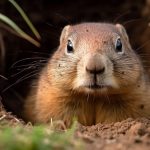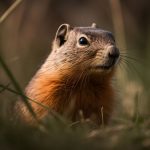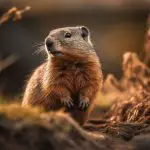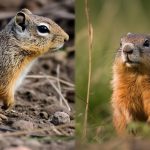Gopher vs Beaver: How Do They Compare?
Rodents have many advantages to the ecosystem, one of them being shaping the landscape and facilitating its growth. Most are a food source for various predators, while others create an environment where predators can find food.
Gophers and Beavers are among the rodents with great impacts on the ecosystem. They share several similarities as well as differences.
So, gopher vs beaver, what’s the difference? Gopher or a Pocket gopher, is a small rodent with a furry tail and short legs. It belongs to the family Geomyidae, which has over 41 species and is under the order Rodentia. Despite their contribution, they can destroy farms with their tunnels and burrows.
On the other hand, a beaver is a fairly big rodent with webbed back feet and a large, flat, and scaly tail. They are semi-aquatic rodents found under the genus castor, under the family Castoridae. They’re widely known for the dams they build, which greatly impact the area’s biodiversity.
The article will compare the two rodents on behavior, diet, and habitats to help you understand them better. So, read on.
Behavior Comparison
One of the many ways to compare the two rodents is through their behaviors, including their activities and feeding patterns. The following section provides a Gopher and Beaver behavior comparison.
Gophers
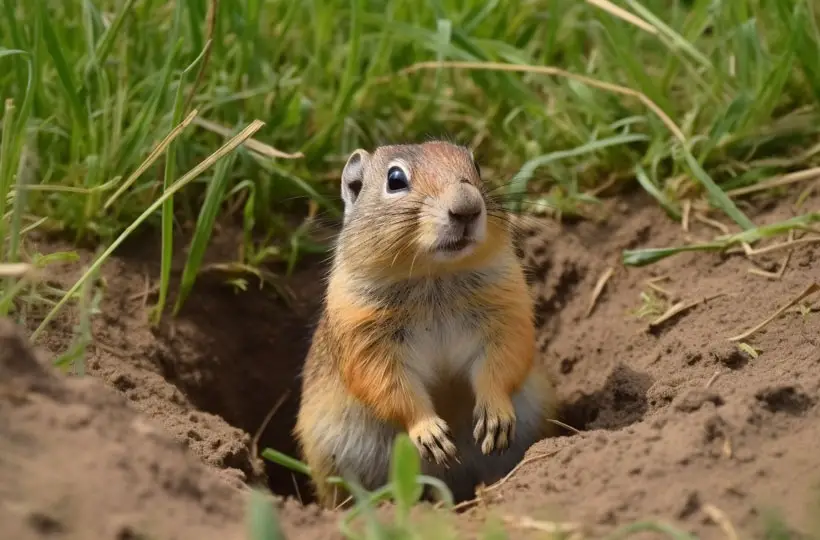
- Gophers use the large claws on their forelimbs to dig while pushing the soil out using their hind legs. Sometimes, these rodents turn and push the soil out with their chest.
- Their ever-growing front teeth come in handy when digging through tree roots. They chew wood when building nests during their mating season.
- Depending on the soil, they can dig up to six feet deep.
- They use these burrow systems for protection against predators and act as their road networks when transporting food to the ground.
- These rodents are hoarders and use their cheek pouches to transport the corrected foods to the burrows.
During spring and fall, the gophers become most active. In North America, this time of year, flowers bloom, and farmers enjoy the opportunity to plant. And the gophers help spread nutrients to the soil through burrowing during that time.
Feeding pattern
However, burrowing cost them 360 and 3,400 times the energy they could have used when walking the same distance on the surface. To compensate for the energy, they eat a lot.
Gophers are territorial and prefer living alone, except during the mating season when they may share burrows. Most of their time is spent underground, building more tunnels, and finding food.
Beavers

- Beavers are semi-aquatic and live in a freshwater ecosystem. The water is advantageous to them, one of which is by protecting them from land predators.
- They prefer living in slow-moving streams, but when that’s not possible, they can live in faster streams, but not too fast.
- They build dams using trees, stones, wood, grass, and mud to survive in fast-flowing streams.
- The dam slows the water and this part of the stream so they can create a beaver lodge.
- A beaver’s lodge is a structure made of sticks
- Beavers prefer living in wetlands areas, streams, rivers, lakes, ponds, and marshes. They live in family units and can be as many as eight in one colony, which includes adults, kits, and yearlings. Yearlings are offspring from a previous year, while kits are from the current year.
- The gopher’s habitats are different from some rodents, like prairie dogs. Prairie dogs prefer dry, flat, and grassland that are sparsely vegetated and acts as a beaver’s shelter, especially during winter. Since they don’t hibernate, they live in these dry and cozy structures.
- These dams greatly impact the ecosystem, one of which is that they prevent soil erosion by slowing water flow. The dams also prevent flooding in case of a storm that may increase water levels.
Feeding patterns
Since they are vegetarians, beavers depend on fresh leaves, twigs, and various aquatic vegetation. During summer, when there’s plenty of food, beavers can eat up to 2kg of different plants and stems. However, during winter, the feeding reduces to at least a kilogram daily.
Comparison of their Behavior to other types of rodents and aquatic mammals
Unlike prairie dogs and chipmunks, both gophers and beavers stay on in winter. The gopher’s caching behavior helps them during winter, while beavers survive on tree bucks.

Also, these rodents are hostile, especially if they feel threatened by an animal. This is unlike some rodents, like hamsters and guinea pigs, which are less hostile toward humans.
Diet Comparison
Another way to compare the two rodents is by the types of plants they eat. This section provides a Gopher and beaver diet comparison to aid in your understanding.
For one, both animals are strict herbivores and eat various vegetation in their habitats. They can survive on plants and sometimes roots and can feed on tender stems.
Gophers

- Gophers prefer to eat roots and bulbs of various plants that come by when burrowing underground.
- They also eat plants’ leaves and stems if it is near the burrow entrance.
- They eat grasses, dandelions, tubers, and tender stems.
- During winter, they gnaw tree bark if their stored foods run out. Even though they are crepuscular animals, active more at dusk or twilight, study shows they may also be active from 1:00 PM to 5:00 PM.
- Gophers use their forelimbs with strong paws to hold onto their food while they eat. They use their chisel-shaped teeth to gnaw on stems and tubers.
- And they carry others in their cheek pouches and deposit them in their burrows.
Impact of Gophers’ feeding habits on their environments
Their feeding habits can also trouble farmers, a reason they are often referred to as garden pests. They are also backyard pests because when excavating, they can fill a yard with piles of soil.
Some people use deterrents, like fish oil, peppermint oil, and coffee grounds, to repel them as a pest prevention method. However, you can also consider contacting local organizations for wildlife removal services.
Beavers

- Beaver’s diet mainly includes aquatic plants, leaves, and woody stems.
- They use their self-sharpening teeth to gnaw on barks and twigs from aspen, birch, poplar, maple, and willow trees.
- Their favorite aquatic vegetation includes cattails, clovers, giant ragweed, and watercress.
- Beavers are also crepuscular, active in the early morning or at dawn, just as the sun sets.
- They’ll spend most of the time in the lodges they build in streams and ponds, where they remain during winter.
- Beavers use their hand-like forelimbs to forage and transport stems to their dens. Their strong flat tail helps them maintain balance when reaching for tree branches.
Impact of beaver feeding habits on their environments
Beavers positively impact the environment through their dams and feeding habits. The dams filter water from floating solids and clean it. However, beavers can harm the forests near their habitats by cutting trees to create the dam. Also, the rising water after a dam construction can kill plants nearby.
Moreover, their dams do more good than bad as they allow fish to increase in the slow-moving waters, providing food for fish-eating prey. Not to forget, beavers themselves are prey to foxes, coyotes, otters, and great horned owls.
Like other rodents, like squirrels and prairie dogs, both gophers and beavers do great for nature and the ecosystem. The gopher tunnels create habitats for various animals and also aerate the soil. Beavers dams also allow the growth and increase of aquatic animals.
Habitat Comparison
The following section provides a gopher and beaver habitat comparison to help you understand the two better.
Gophers
Gophers are found in the Northwestern United States, some areas of the Southeastern, and Canada. Beavers are also found in North America but also available in northern Mexico and Canada.
The two extant beaver species are the American beaver, castor canadensis, and the Eurasian beaver, Castor fiber. Before there were trapping regulations, beavers were in high demand for their fur, and castoreum substance was used as perfume and medicine.

There are at least 41 gopher species in the world today, with some popular ones including Botta’s pocket gopher. They are mostly known for their burrowing and ability to destroy farms. Dealing with them might involve using Professional wildlife control agents.
Gophers are most times found in lands with soft soils where they can easily create tunnels and burrows. They also prefer places where plenty of plants are available. Many gophers can live and tunnel in one area but not live together, and one place can have thousands of gopher residents.
Beavers
On the other hand, gophers prefer places with more vegetation and soft soil.
Beaver’s habitats are more like those of a Muskrat who prefers wetlands and swamps. However, unlike muskrats, beavers build dams before building their lodges. Muskrats look for slow-moving water to build their lodges at the banks.

FAQs
Following are the frequently asked questions on gopher vs beaver.
Q: How deep do gophers and beavers burrow?
Beavers can build burrows with average lengths of 196 inches in the banks. Gophers, on the other hand, can build a tunnel as deep as 72 inches. However, they mostly burrow 6 to 12 inches below.
Q: Do gophers and beavers hibernate?
No. Gophers and beavers do not hibernate but rather survive in habitats using their stored foods. Gophers continue to burrow below the ice, while beavers occasionally come out to feed on stems.
Q: What are the predators of gophers and beavers?
Gophers and beavers are prey to Coyotes, foxes, and bobcats. However, owners use domestic dogs and cats in case of yard or lawn damage. Great-horned owls also prey on beavers.
Conclusion
The article includes a comparison of gophers and beavers based on various things. And the key points include;
- Gophers are territorial and prefer living alone except for the mating season
- Beavers live in colonies which can have members between two and eight
- Both rodents eat plants, stems, and are strictly herbivores
- Gophers and beavers are found in North America
Rodents make up to 40% of all mammals, and it’s fundamental to understand each of their behavior, diet, and habitats. This knowledge comes in handy while managing and conserving wildlife as you know what works for each rodent.
However, there is more to know about gophers and beavers, which you can study in several research papers. Also, since these animals can damage gardens and waterways, further research on this purpose is necessary. Also, consider notifying wildlife authorities to remove and take care of them.

